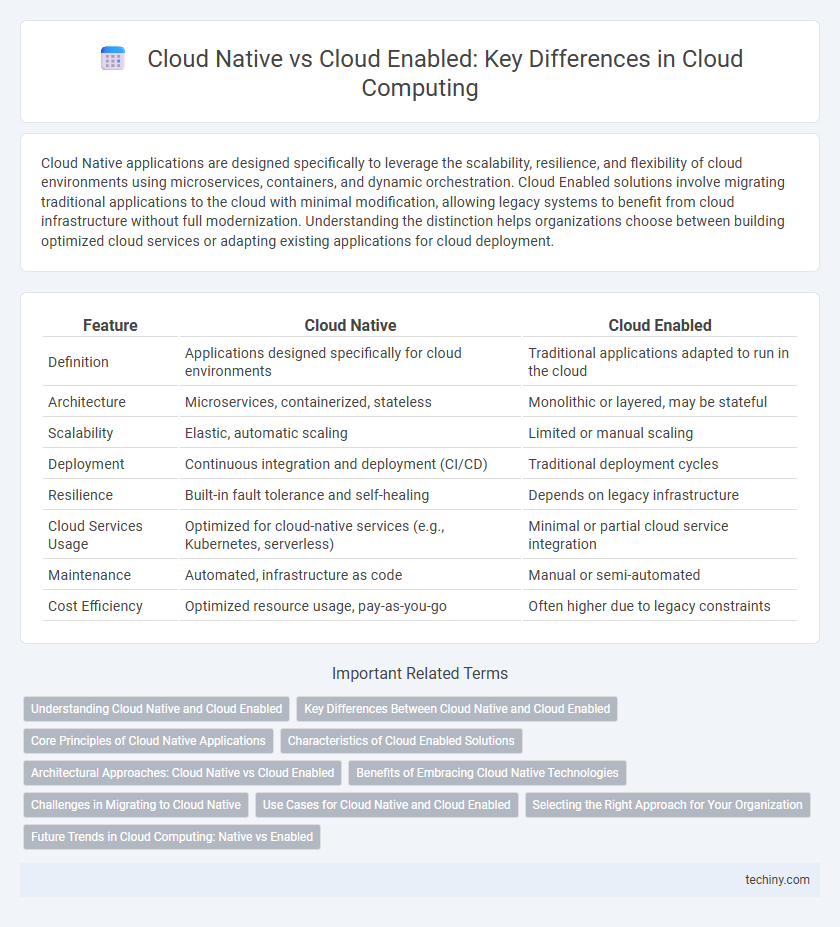Cloud Native applications are designed specifically to leverage the scalability, resilience, and flexibility of cloud environments using microservices, containers, and dynamic orchestration. Cloud Enabled solutions involve migrating traditional applications to the cloud with minimal modification, allowing legacy systems to benefit from cloud infrastructure without full modernization. Understanding the distinction helps organizations choose between building optimized cloud services or adapting existing applications for cloud deployment.
Table of Comparison
| Feature | Cloud Native | Cloud Enabled |
|---|---|---|
| Definition | Applications designed specifically for cloud environments | Traditional applications adapted to run in the cloud |
| Architecture | Microservices, containerized, stateless | Monolithic or layered, may be stateful |
| Scalability | Elastic, automatic scaling | Limited or manual scaling |
| Deployment | Continuous integration and deployment (CI/CD) | Traditional deployment cycles |
| Resilience | Built-in fault tolerance and self-healing | Depends on legacy infrastructure |
| Cloud Services Usage | Optimized for cloud-native services (e.g., Kubernetes, serverless) | Minimal or partial cloud service integration |
| Maintenance | Automated, infrastructure as code | Manual or semi-automated |
| Cost Efficiency | Optimized resource usage, pay-as-you-go | Often higher due to legacy constraints |
Understanding Cloud Native and Cloud Enabled
Cloud Native applications are designed and built specifically to leverage the scalability, flexibility, and resilience of cloud environments using microservices, containerization, and dynamic orchestration tools like Kubernetes. Cloud Enabled refers to traditional applications that have been modified or migrated to run in the cloud without fundamentally changing their architecture. Understanding the distinction between Cloud Native and Cloud Enabled is crucial for optimizing application performance, cost efficiency, and scalability in cloud computing environments.
Key Differences Between Cloud Native and Cloud Enabled
Cloud Native applications are designed specifically for cloud environments, leveraging microservices, containers, and continuous integration/continuous deployment (CI/CD) pipelines to maximize scalability and agility. Cloud Enabled applications are traditional on-premises software adapted to run in the cloud, often through virtualization or rehosting, without significant architectural changes. Key differences include Cloud Native's inherent cloud architecture for optimized performance versus Cloud Enabled's reliance on legacy frameworks with limited flexibility and cloud-specific benefits.
Core Principles of Cloud Native Applications
Cloud Native applications are designed with core principles such as microservices architecture, containerization, and continuous integration/continuous deployment (CI/CD) to maximize scalability and resilience. These applications leverage dynamic orchestration through platforms like Kubernetes, enabling automated management and efficient resource allocation. Cloud Enabled systems, by contrast, are traditional applications adapted to run in cloud environments without fully embracing these cloud-native design principles.
Characteristics of Cloud Enabled Solutions
Cloud enabled solutions are traditional applications adapted to run in cloud environments without extensive redesign, emphasizing scalability and improved resource utilization. They typically retain monolithic architectures but leverage cloud infrastructure benefits such as on-demand provisioning and automated management. Key characteristics include compatibility with existing software, incremental migration, and reliance on virtualization for deployment efficiency.
Architectural Approaches: Cloud Native vs Cloud Enabled
Cloud native architecture is designed specifically for cloud environments, leveraging microservices, containerization, and automated orchestration to maximize scalability, resilience, and continuous delivery. Cloud enabled architecture involves migrating traditional applications to cloud infrastructure with minimal changes, focusing on lift-and-shift strategies to improve resource utilization without fully exploiting cloud-native features. This architectural distinction affects operational efficiency, deployment agility, and the ability to innovate rapidly within cloud ecosystems.
Benefits of Embracing Cloud Native Technologies
Embracing cloud native technologies enhances agility and scalability by leveraging microservices, containers, and serverless architectures designed specifically for cloud environments. This approach significantly improves resource efficiency and accelerates application deployment cycles compared to traditional cloud enabled applications, which often rely on legacy systems adapted for the cloud. Organizations benefit from increased resilience, faster innovation, and optimized operational costs through native integration with cloud platforms and automated management tools.
Challenges in Migrating to Cloud Native
Migrating to cloud native architecture involves complex challenges such as refactoring legacy applications to leverage microservices, containerization, and orchestration tools like Kubernetes. Organizations often face skill gaps in cloud-native development and operational practices, increasing the risk of prolonged downtime and integration issues. Ensuring data security, compliance, and seamless DevOps automation further complicates the migration from cloud-enabled to fully cloud-native environments.
Use Cases for Cloud Native and Cloud Enabled
Cloud Native applications leverage microservices architecture and containerization to enable rapid scaling, continuous delivery, and resilience, making them ideal for real-time data processing, IoT platforms, and dynamic web services. Cloud Enabled solutions involve migrating legacy systems to the cloud environment to improve accessibility and cost efficiency, commonly used in traditional enterprise resource planning (ERP) and customer relationship management (CRM) systems. Both approaches serve critical roles in digital transformation, with Cloud Native optimized for innovation and agility, while Cloud Enabled supports modernization of existing infrastructure.
Selecting the Right Approach for Your Organization
Cloud Native applications leverage containerization, microservices, and continuous integration/continuous deployment (CI/CD) pipelines to maximize scalability, agility, and resilience, making them ideal for organizations aiming to fully exploit cloud capabilities. Cloud Enabled solutions involve migrating or adapting existing legacy systems to the cloud environment without redesigning architecture, suitable for organizations seeking cost-effective, incremental cloud adoption. Selecting the right approach depends on factors such as the organization's digital transformation goals, existing infrastructure, budget constraints, and the desired level of operational flexibility and innovation.
Future Trends in Cloud Computing: Native vs Enabled
Cloud Native architectures leverage microservices, containers, and dynamic orchestration to enhance scalability, resilience, and continuous integration, positioning them as the cornerstone for future cloud innovation. Cloud Enabled systems adapt existing legacy applications for cloud deployment, offering incremental modernization but often facing limitations in agility and full cloud optimization. Emerging trends indicate a shift towards Cloud Native development driven by AI integration, serverless computing, and edge cloud capabilities, ultimately shaping more autonomous, efficient, and scalable cloud ecosystems.
Cloud Native vs Cloud Enabled Infographic

 techiny.com
techiny.com